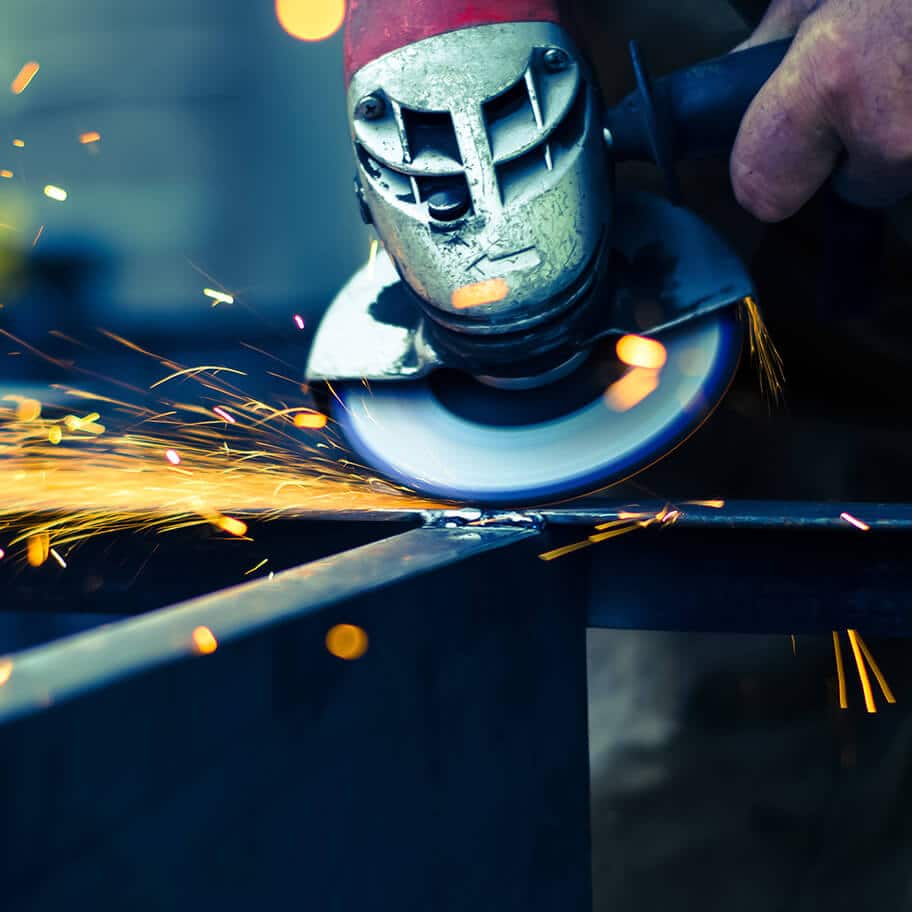A Powerful Tool
Angle grinder accidents can occur in cases where an inexperienced or untrained person is using this tool to cut/polish stone, concrete and metal. This handheld tool is powered via compressed air or via a motor and is used in many industries such as welding, farming and vehicle repairs. If used incorrectly, angle grinders can cause various injuries, ranging in severity. In some cases, these work-related accidents can lead to fatalities.
Who is Liable?
When making an accident at work claim it is important to determine who is liable for the cause of your accident and the injuries you have sustained. In many cases, it may be found to be either the employer or employee. Many workplace accidents are caused by either negligent behaviour or a breach of duty of care.
Employers
All employers have a duty of care to their employees to ensure that their health and safety is a priority throughout the course of their work. They have a responsibility to carry out frequent risk assessments in order to identify and eliminate potential hazards which could lead to an accident. They also have certain duties which should be carried out to help prevent accidents in the workplace. These duties are outlined in the Safety, Health and Welfare at Work Act 2005 and include;
- Managing activities in a way which prioritises health and safety
- Providing adequate training and Personal Protective Equipment (PPE)
- Ensuring that the workplace is practical for the work that is to be carried out
A breach of these duties could potentially lead to an accident which the employer may be found liable for. In many cases, claims made following an accident at work are made against an employer for their negligence.
Employees
Workplace accidents can also be caused by employees who have failed to co-operate with the regulations in place and acted in a negligent manner. If it is found that they have failed to show a reasonable duty of care causing an accident, then they may be found liable and any claim made against their employer may be unsuccessful. Employees also have certain duties which should be complied with to ensure the health and safety of both themselves and their co-workers.
- Co-operating with their employer in following regulations in place
- Attending any training that is provided to them by their employer
- Report any problems or defects which they come across during the course of their work
It is important to note that if it is found that you have contributed to the cause of your accident, through contributory negligence, you may affect your claim.
Common Injuries
Some of the common injuries sustained from an angle grinder accident include:
- Cuts and Lacerations
- Face Injuries
- Eye Injuries
- Breaks and Fractures
- Burns
- Fatalities
- Amputations
- Industrial diseases caused by overexposure to hazardous chemicals and materials
Causes
Lack of Training
All employees should be provided with adequate training prior to undertaking their work. This helps to prevent accidents in the workplace and make it easier for their work to be carried out correctly and in a safe manner. This can also help to prevent accidents as people will be more aware of what is expected of them. Workplace machinery that is used by an untrained employee could lead to long-term injuries.
Inadequate Personal Protective Equipment (PPE)
An employer has a responsibility to ensure that their employees are provided with the correct protective equipment in order to carry out their job. This includes footwear, gloves, clothing, hats, goggles and facial masks. Failing to provide this is a common cause of accidents and injuries. This can leave employees more at risk of sustaining an injury as they do not have the added protection level that is required when using dangerous machinery and equipment.
Faulty Equipment
Equipment and machinery that is used in the workplace should be maintained to a high standard at all times. Over time, as the machinery and equipment are used on a regular basis, it is likely that there will be some wear and tear. If they are not maintained it is likely to lead to an employee injury occurring. Faulty equipment could also be a potential risk as it will not work as it is supposed to. This is generally as a result of negligence caused by the manufacturer.
Safety Guards
Safety guards should be fitted on all equipment and machinery in the workplace to avoid an accident such as fingers becoming trapped or degloving injuries. Failing to provide these guards can lead to serious injuries being sustained. It is important that these guards are checked regularly to ensure that they are not broken and still can be used for their intended purpose,
What to do after an accident at work*?
Following an accident at work, there are a number of steps you should follow:
-
Seek medical attention
Your health is your wealth and should be your first priority. Immediately after an accident at work, take a second to assess yourself to determine if you have any injuries and seek the relevant medical attention. If you have sustained a serious injury ensure that you contact an ambulance to attend the scene.
For minor injuries, you must remember that minor injuries where you ‘feel fine’ could progress to more serious injuries in the future. In this case it is always better to be safe than sorry and advisable that you go to your nearest accident and emergency (A&E) or local GP to be checked out.
-
Report the accident
It is critical to report the accident to your superior, i.e. a supervisor or manager on site. It doesn’t matter how small you think the accident may be. By law, accidents at work are required to be reported if the person is injured and can’t perform their daily work tasks for more than three days. Make sure to fill out an Accident Report Form. This can be used for reference in any medical examination and will also prevent any similar accidents from happening in the future.
-
Identify any witnesses
If possible, try to collect the contact details of anybody that witnessed your accident. This may be of use if you do decide to pursue a workplace accident claim. It is also useful to find out if there is any CCTV in the area where your accident happened.
-
Document the incident
It is important that you collect all the relevant information in connection with your accident:
- How the accident happened
- Details of any witnesses
- If there are any CCTV recordings of your accident
- Take pictures of where the accident happened and what caused your accident
-
Speak to a workplace accident solicitor
If you are considering moving forward with a workplace accident claim for any personal injuries sustained, it is advisable that you speak with a workplace accident claims solicitor as soon as possible. If you are proceeding with a claim, the first step will be submitting your claim to the Personal Injuries Assessment Board (PIAB) for assessment. A workplace accident solicitor can help you in preparing your application to the Personal Injuries Assessment Board (PIAB) and ensure that you follow the process in the correct format, meaning that you can move forward with your claim quickly without unnecessary delays.
It is important to remember to keep copies of any expenses that you have incurred as a result of the accident. It is also imperative to retain copies of medical reports or incident report forms where possible as you will need them when making a claim.

